
San Sebastian Cheesecake (Burnt Basque Cheesecake)
San Sebastian Cheesecake is a super easy and no fuss cheesecake recipe known for its unorthodox charred top, no crust and dreamy custard-like center.
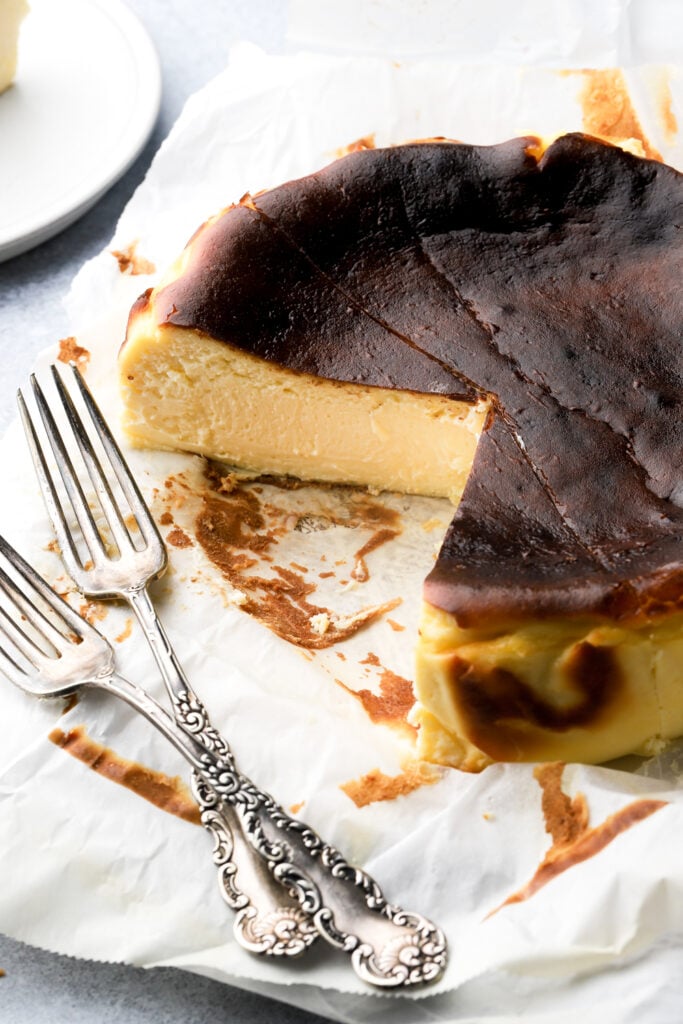
Why you’ll love this San Sebastian cheesecake
- The Ingredients and the process are simple and it does NOT require a water bath!
- It’s sooo smooth and creamy and has the texture of custard.
- The cheesecake is made in a regular pan and doesn’t require a springform pan.
- Embraces the cracks and the sinking in the middle that generally isn’t preferred for traditional cheesecakes.
- Definitely a statement dessert.
If you’re a cheesecake lover, I think you’ll love my very basic vanilla cheesecake that can be made in so many flavors and sizes! I used it to make a biscoff cheesecake and a pistachio cheesecake.
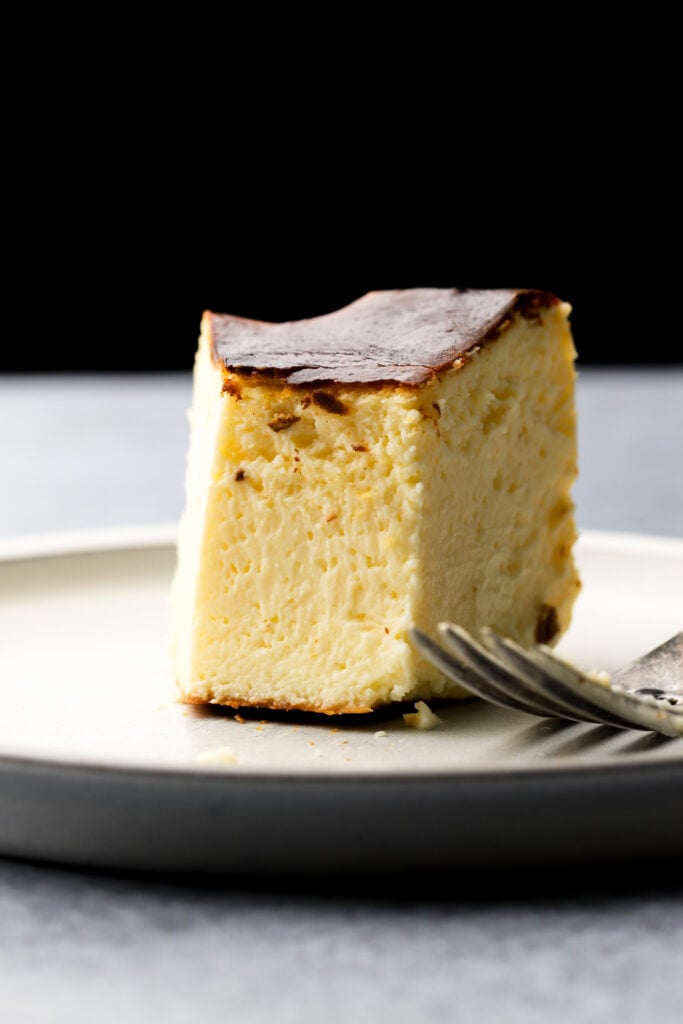
Ingredients & substitutions
- Cream Cheese: make sure to use the full-fat brick cream cheese. I prefer the Philadelphia brand.
- Sugar: I used granulated sugar and I haven’t tested the recipe with other sugars. I don’t recommend reducing the sugar either as it’s not overly sweet and it may affect the texture.
- Cornstarch: this will help the cheesecake set nice and custardy.
- Vanilla: I recommend vanilla bean paste or actual vanilla beans. If you’re in a pinch, pure vanilla extract works well too.
- Eggs: Use large, room temperature eggs (55-60 grams without the shell).
- If you’re in a pinch, place them in hot water for 5-10 minutes.
- Heavy Whipping Cream: Make sure to bring the heavy whipping cream to room temperature before using it.
- I tried substituting this for milk/sour cream/butter mixtures but it didn’t work well so I recommend sticking to the cream.
Step-by-Step Instructions
Step 1: Prepare your pan by lining it with two large sheets of parchment paper, leaving an overhang off the edge. I like to secure it with four metal binder clips.
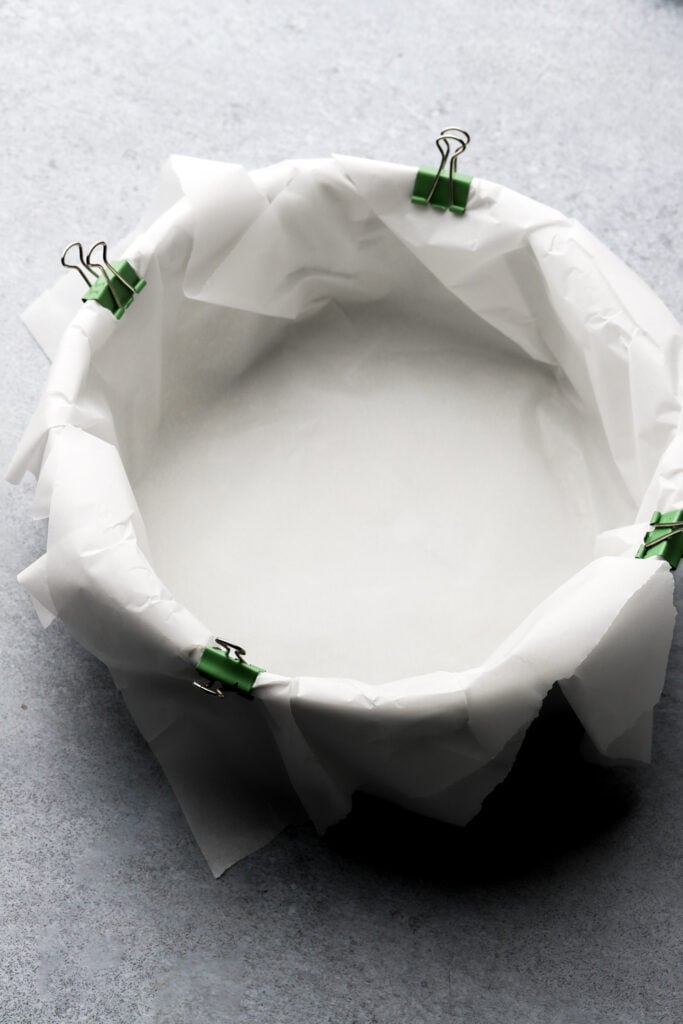
Step 2: Combine the cream cheese, sugar, cornstarch and vanilla in a large bowl or the bowl of a stand mixer. Mix on low speed for 2-4 minutes, just until it’s smooth and there are no more chunks of cream cheese.
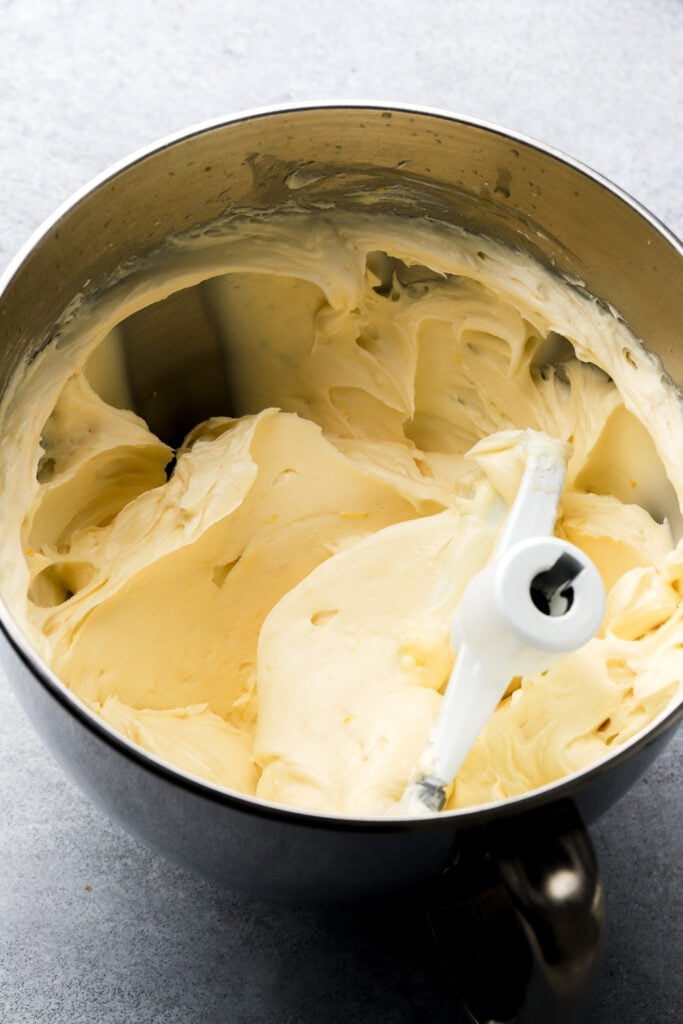
Step 3: Add in the eggs, one at a time, with the mixer running on low speed, allowing each one to incorporate before adding the next.
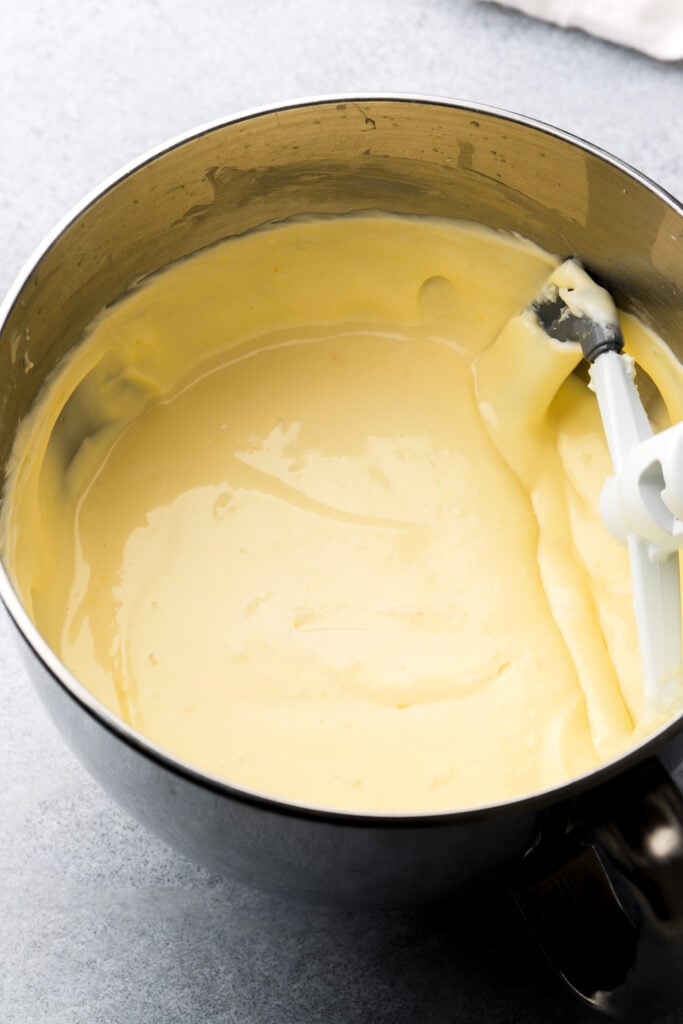
Step 4: Stream in the heavy whipping cream while the mixer is still running at low speed. Mix just until it’s all combined.

Step 5: Pour the batter through a sieve and into the prepared pan. Bake at 400F (204C) for 45 minutes (if you want the top even darker, feel free to broil it the last 1-2 minutes). Then remove it from the oven and allow it to cool to room temperature.

Step 6: Cheesecake should be light-medium brown on top if not broiled (dark if broiled) and still have good jiggle in the center. Let it cool on the counter for a few hours before transferring to the fridge for at least 4-6 hours or overnight.

Expert tips to get the perfect bake
- This cheesecake is baked at a higher temperature than normal. I did 400F/204C in a convection oven because I figured the rotating heat from the fan would nicely brown the top of the cheesecake.
- Although convection ovens normally adjust to 25F less than what you set it to, my oven still read 400F/204C so I left it that – make sure to have an oven thermometer.
- If you don’t have a convection oven, still bake it at 400F/204C in a conventional oven and give it an extra 2-3 minutes – the top might brown a little less.
- If the top hasn’t browned sufficiently by 42-44 minutes, feel free to put the oven on broil for the last 1-2 minutes.
- Allow it to cool at room temperature for a couple of hours and then refrigerate it until it’s completely cooled and feels set.
- Again, I HIGHLY recommend an oven thermometer because if your oven runs hot, it can curdle the batter and you’ll end up with a grainy/curdled seeping cheesecake.

How to know when the cheesecake is done baking?
This is the most crucial part of the recipe. You can do everything perfectly and if you over-bake it, it’ll be eggy and can curdle. If you underbake it, it won’t set properly and will be a loose, runny custard.
In my opinion, under-baked is better than over-baked cheesecake and that’s especially true for this San Sebastian cheesecake.
When the cheesecake is ‘done’, the edges will be puffed, the top will have browned at least a little (a little more with convection oven) and the center will still be jiggly. Not like a traditional cheesecake, where the center has a slightly wobble, this will be jiggly.
At this point, if you want the top darker just broil it for 1-2 minutes, it will darken VERY quickly and the center will puff as well. When you remove it from the oven, it will shrivel back up and sink in the center.
At room temperature, the cheesecake will probably still not be set enough to slice so I recommend refrigerating for at least 4-6 hours or overnight. It’s a perfect custard when you serve it cold from the fridge.
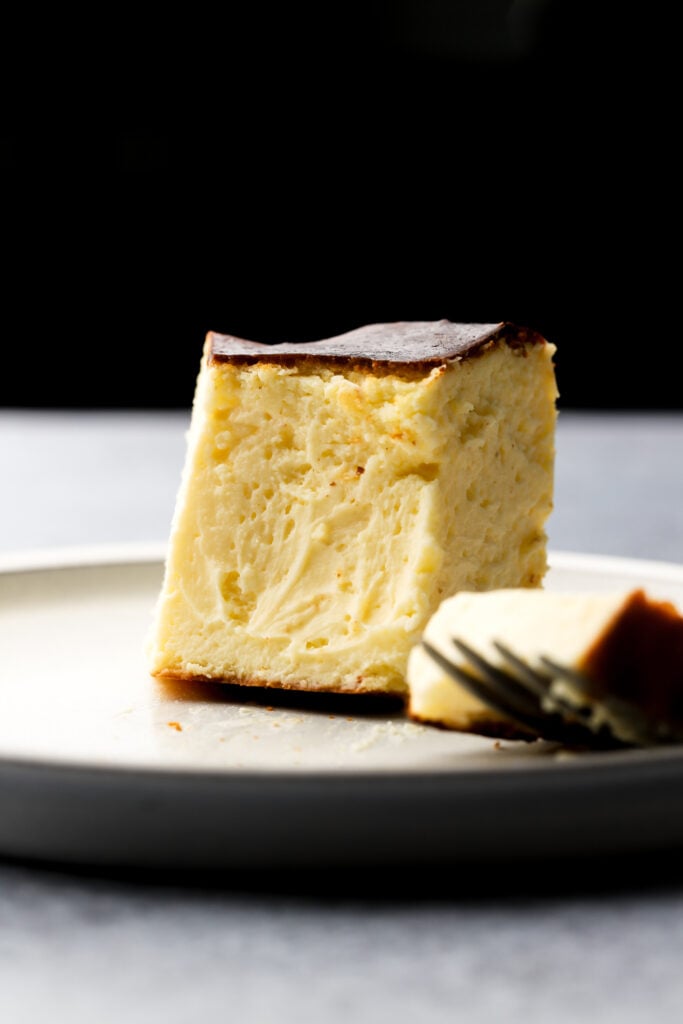
How to flavor a burnt basque cheesecake
The star of the San Sebastian cheesecake is the burnt top which provides a rich caramelized flavor. If you do want to flavor it differently, you can top it when any sort of topping like:
- fresh strawberries
- blueberry topping
- cherry topping
- raspberry filling
- seedless raspberry filling
- rhubarb jam
- caramelized white chocolate ganache
- salted caramel sauce
- chocolate ganache
You could also use lemon, lime or orange juice and include the zest (skip the sieve but make sure not to have any chunks of cream cheese in the batter and don’t over-beat to include air.
I have NOT tested this but I’m sure you could remove ½ cup of heavy whipping cream and mix in a cup of cookie butter, peanut butter, Nutella, caramel, etc. If you try it let me know!
I kind of want to swap out the cornstarch for ¼ cup of cocoa powder and see how that turns out!

How to bake this cheesecake in different size pans
I used an 8×3 inch cake pan to make this cheesecake and it turned out fairly tall, like I intended so I don’t think you could use an 8 inch pan that’s only 2 inches tall.
You could bake it in a 9×2 inch pan though and it would just be a little shorter. That would also probably require 5-10 minutes less of bake time.
My guidelines for traditional cheesecake is to double the recipe if I want to use a 10 inch pan, half the recipe if I want to use a 6 inch pan and 1.5x the recipe for a 9inch pan (to keep the same height).
I haven’t tested all those guidelines for this specific cheesecake but that guideline works well for my vanilla cheesecake recipe which produces a similar amount so I predict that it would work well. Timing of baking might be up in the air but look for the cues. You want it puffed and set around the edge, browned on top at least a little and jiggly in the center.
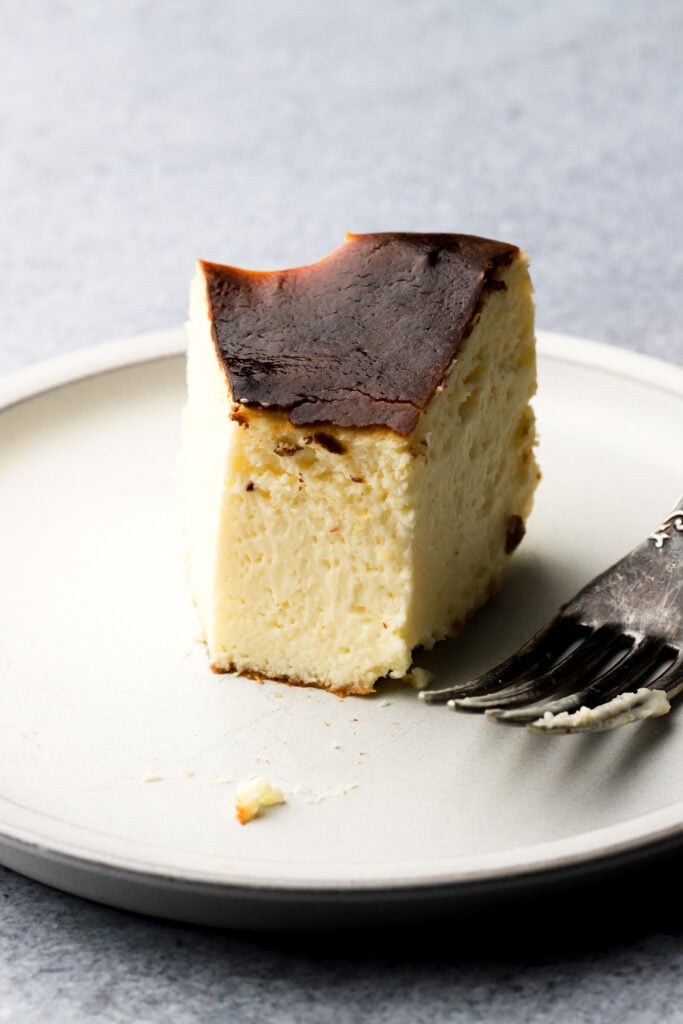
Troubleshooting cheesecake
If your cheesecake is liquid-y/runny custard in the center, after it’s been chilled then it needed a few more minutes in the oven.
If it is grainy/curdled and releases a lot of liquid after it’s been chilled, then the oven was either too hot, the cheesecake was over-baked or both.
If it’s perfectly set and custardy after being chilled but it’s seeping liquid – this is normal but it shouldn’t be a lot. It definitely sweats more on the parchment paper so I just moved it to a paper towel to soak off the liquid and then serve.

How to store cheesecake
To refrigerate, cover the cheesecake with foil or plastic wrap and refrigerate it for up to a week. Serve cold or slightly chilled.
To freeze the whole cheesecake, wrap it in plastic wrap and then wrap it again in aluminum foil (or place it in an airtight container big enough).
To freeze slices, place them tightly in an airtight container and then place the container in a freezer bag, squeezing out all the excess air. Thaw in the refrigerator overnight or bring to room temperature for a few hours before serving.
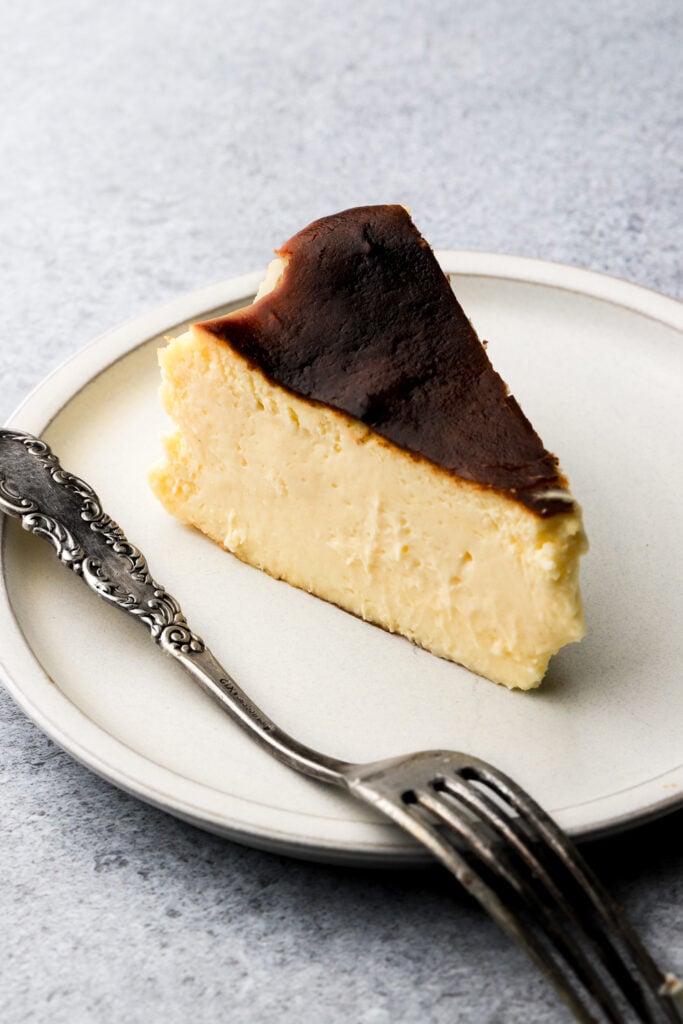
Thanks so much for reading today’s post, if you have any questions just comment down below.
If you make my San Sebastian cheesecake recipe, I’d love it if you left a star rating for me. If it’s less than five stars, please leave a comment with the rating so I know why! 🙂
As always, have a blessed day and happy baking!
Love, B

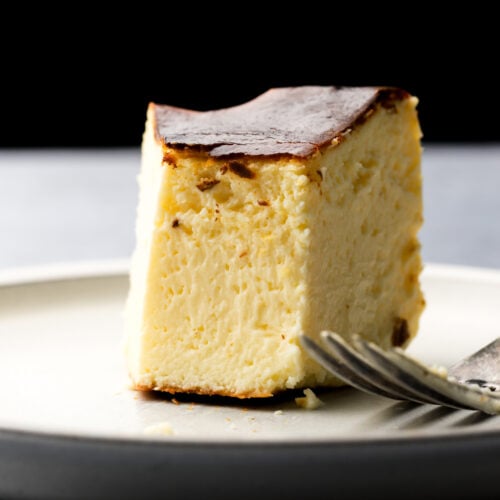
Hey guys I baked this cake yesterday and it was amazing I cut the ingredients in half because we are only 3 people. I wish I hadn’t done that. It disappeared immediately. One tip. After half an hour in the oven I turned off the oven but didn’t open it the cake stayed for 10 mins to caramelise the top
I’ve made this several times and it is perfect every time. It’s just delicious. Sometimes we speak some slightly warmed warmed Dulce de leche, but it’s perfect either way.
One question though: do you remove it from the pan before or after refrigeration? The instruction aren’t clear on this point so wondering what you do. Thx!
After refrigerating! Glad you like the cheesecake, thank you for sharing!
Followed the recipe to the letter, using a convection oven and all room temperature ingredients, and it came out perfectly. Great recipe, thanks!
The best recipe for san sebastian cheesecake.
Thank you.
I LOOOOOOVE this cheesecake but I have one problem. I bake at at 390 degrres F for 40 min but the center is not runny! What am I doing????
Your oven might just run hotter than mine, reduce the time in the oven a little and if you want to brown the top more, broil for a minute at the end.
If I don’t have vanilla extract, I can use vanilla sugar
This recipe is perfect. The cheesecake turns out perfect and I’m glad I finally got to make it as I don’t like the cheesecake with crumbs base so this is a perfect replacement! I didn’t put as much sugar in it and the people I bake for are trying to cut sugars from our diet but they still taste amazing! I appreciate you putting each ingredient in each step reminding us what specific ingredient in what step, helps a lot. Wish I can show you the outcome photos as it looks perfect! This would be my go-to recipe every time I make it now! Thank you!
A question- I’ve made many cheesecakes and agree an oven thermometer is essential. I use two just in case!
In my country we get whipping cream or double cream. The latter does not whip and the former is not ‘heavy’. Which would be best. I will definitely use Philadelphia and everything else you listed.
Many thanks and excited to make this.
Either should be fine but I believe your whipping cream is more comparable to what we use in the US 🙂
Hi Jenn,
The cheesecake turned out perfect. It’s resting in the fridge. I am a bit nervous to remove it from the pan. I didn’t use springform or the removable bottom pan. However, I lined the parchment paper with butter and used metal pegs to support the parchment paper sticking out.
Please share your expert advise to remove it from the regular 8-inch pan.
I am planning to remove it in the morning once the cheesecake is chilled by using parchment paper as handles.
Loved the recipe! Easy to make and delicious!
Made this for a dinner party and it came out perfectly! Was thrilled. This will now be my go-to cheesecake recipe.
I used a 9″ pan and baked for 40min in a convection oven.
Tried to make this cheesecake a couple of times but it does not work. I don’t know what I am doing wrong apart from the fact that I used a handmixer. I use the whiskers at the lowest speed, which is still rather fast. Anyway the problem seems to be that as soon as I pour the eggs in my batter becomes very liquid. I tried to mix everything by hand but idem. When I compare my batter to the batter in videos I find it too runny.
Now my cheesecake seems to rise in the oven but then collapses, not like the one on the pictures a bit, but I have hardly 2 cm left and something which is like a ultra dense and heavy. The taste is not bad but no fluffiness at all.
Should I put in more flour? But I don’t see how the flower is a factor for keeping the cake fluffy.
It’s very frustrating because I read everywhere that this cake is very easy to make but that’s not my experience.
Hi I’m sorry it hasn’t it worked out for you. You mentioned using flour but the recipe calls for cornstarch. How much flour did you use? You would definitely need at least double the amount of flour in place of cornstarch but I haven’t tested the exact amount needed.
If it collapses like that, it sounds like it’s under-baked and that can happen if not enough liquid is absorbed which would be the case if you used flour in place of cornstarch and didn’t increase the amount enough. Looking forward to hearing back from you!
Hi Bernice! This recipe is my first acquaintance with you and your beautiful blog. I do admire your style of writing and cooking suggestions! Thank you for your inspiration!
Speaking about San Sebastián, I really enjoyed how it turned out: very delicate sweetness and tender texture! I will definitely cook it again! The only concern is that my San Sebastian turned out to be quite moist; when I took it out of my fridge, I decided to use a napkin to get rid of visible moisture. What might be a reason for that? To be honest, I could not find a cornstarch, so I went for all purpose flour instead. Was it a wrong decision, and the reason for moisture?
Hi Irina, I haven’t tested it on this particular recipe but usually if you’re replacing cornstarch with flour you’ll need about double the amount.
A little seeping is normal on the parchment paper so i transfer it off the parchment after it’s chilled but if it’s a lot then it’s probably from the cornstarch/flour issue 🙂
This cheesecake is FANTASTIC! I made sure all my ingredients were room temperature, so they combined without any problems. I did weigh most of the ingredients just to make sure everything was accurate. I ended up baking it in a springform pan with the parchment paper, just because I don’t have any 8-inch cake pans (sad, right?). The cheesecake rose in the oven and then shriveled accordingly once I took it out. I did mess up and bake it at 350 for the first 15 minutes before realizing my mistake and adjusting the temperature. I was pretty nervous about taking it out at the right time, but after letting it in a few extra minutes to make up for the low initial temperature, I removed it from the oven when there was still a pretty big jiggle and it was perfect! The texture was so creamy and smooth, and it was deliciously dense- just like a cheesecake should be! The top was caramelized very nicely, which added an extra layer of richness to it. I think this would be delicious with a chocolate ganache, or even a caramel or raspberry sauce. One of my favorite things about this cheesecake was how easy it was, but at the same time, it looked and tasted so gourmet! I think it was even better the next day, so if I was making this for an occasion, I might make it the night before. Anyway, this recipe is definitely a keeper!
Substitute for 4 large eggs ?
Do you use a 8” cheese cake pan? If not how do you remove the cake??
It’s a regular cake pan and removed with the parchment hanging over